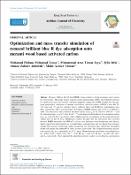Options
Optimization And Mass Transfer Simulation Of Remazol Brilliant Blue R Dye Adsorption Onto Meranti Wood Based Activated Carbon
Journal
Arabian Journal of Chemistry
Date Issued
2023
Author(s)
Mohamad Firdaus Mohamad Yusop
Muhammad Azan Tamar Jaya
Iylia Idris
Ahmad Zuhairi Abdullah
Mohd Azmier Ahmad
DOI
https://doi.org/10.1016/j.arabjc.2023.104683
Abstract
Remazol brilliant blue R dye (RBBR) brings toxicity to living organisms once it enters the environment. This study utilized response surface methodology (RSM) and Polymath software for optimization and mass transfer simulation purposes, respectively. RSM revealed that the optimum preparation conditions of meranti wood-based activated carbon (MWAC) were 441 W, 5.76 min, and 1.35 g/g for radiation power, radiation time, and KOH:char impregnation ratio (IR), respectively, which translated into 86.39 mg/g of RBBR uptakes and 31.94 % of MWAC’s yield. The simulation study predicted the mass transfer rate, rm to be 112.20 to 1007.50 s 1 and
the adsorption rate, k1 to be 3.96 to 4.34 h 1 . The developed model predicted the adsorption surface area, am to be 790.04 m2 /g and this value is highly accurate as compared to the actual mesopores surface area of 825.58 m2 /g. Mechanism analysis divulged that the interaction that occurred between RBBR molecules and MWAC’s surface were hydrogen bond (methylene and alkyne), dipole–dipole force (alkyl carbonate, terminal alkyne, and methoxy), and ion–dipole force (primary amine). The isotherm and kinetic studies found that the adsorption data obeyed the Freundlich model and pseudo-first-order (PFO) model the best, respectively. The Langmuir maximum adsorption capacity, Qm was computed to be 327.33 mg/g. Thermodynamic parameters were calculated to be 4.06 kJ mol 1 , 0.06 kJ mol 1 K 1 , –22.69 kJ mol 1 , and 16.03 kJ mol 1 for DH , DS , DG , and Ea, respectively, which signified the adsorption process studied was exothermic, spontaneous and governed by physisorption.
the adsorption rate, k1 to be 3.96 to 4.34 h 1 . The developed model predicted the adsorption surface area, am to be 790.04 m2 /g and this value is highly accurate as compared to the actual mesopores surface area of 825.58 m2 /g. Mechanism analysis divulged that the interaction that occurred between RBBR molecules and MWAC’s surface were hydrogen bond (methylene and alkyne), dipole–dipole force (alkyl carbonate, terminal alkyne, and methoxy), and ion–dipole force (primary amine). The isotherm and kinetic studies found that the adsorption data obeyed the Freundlich model and pseudo-first-order (PFO) model the best, respectively. The Langmuir maximum adsorption capacity, Qm was computed to be 327.33 mg/g. Thermodynamic parameters were calculated to be 4.06 kJ mol 1 , 0.06 kJ mol 1 K 1 , –22.69 kJ mol 1 , and 16.03 kJ mol 1 for DH , DS , DG , and Ea, respectively, which signified the adsorption process studied was exothermic, spontaneous and governed by physisorption.
Subjects
File(s)
Loading...
Name
Optimization and Mass Transfer Simulation of Remazol Brilliant Blue R Dye Adsorption Onto Meranti Wood Based Activated Carbon.pdf
Size
1.58 MB
Format
Adobe PDF
Checksum
(MD5):da76f5fe7aa128472468c2779a918706